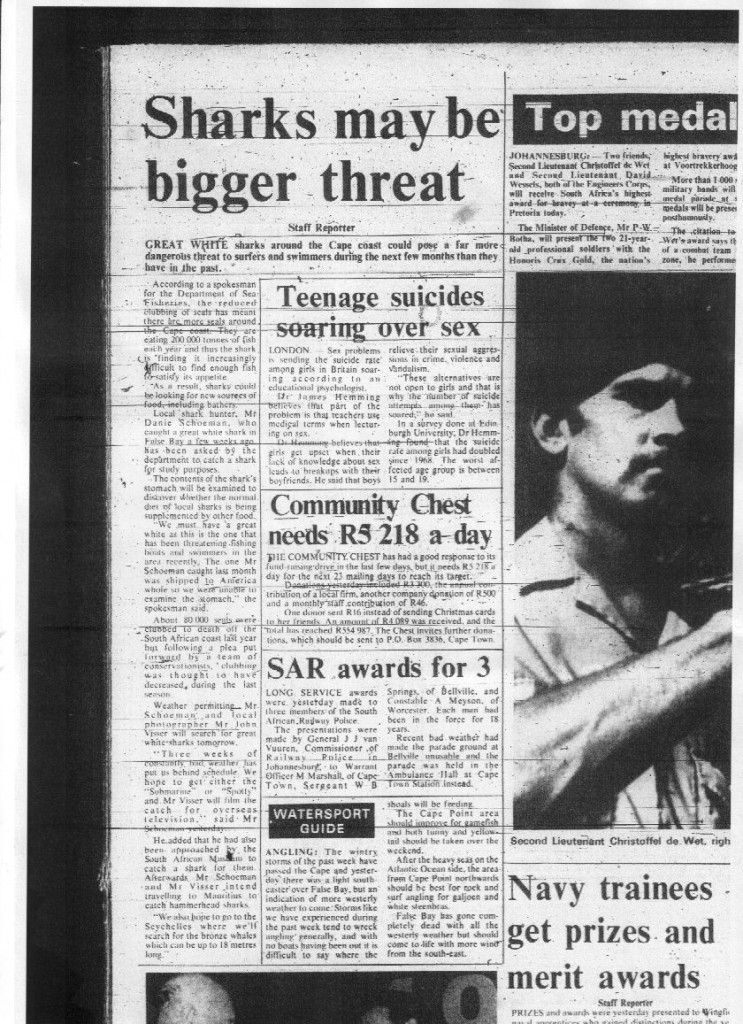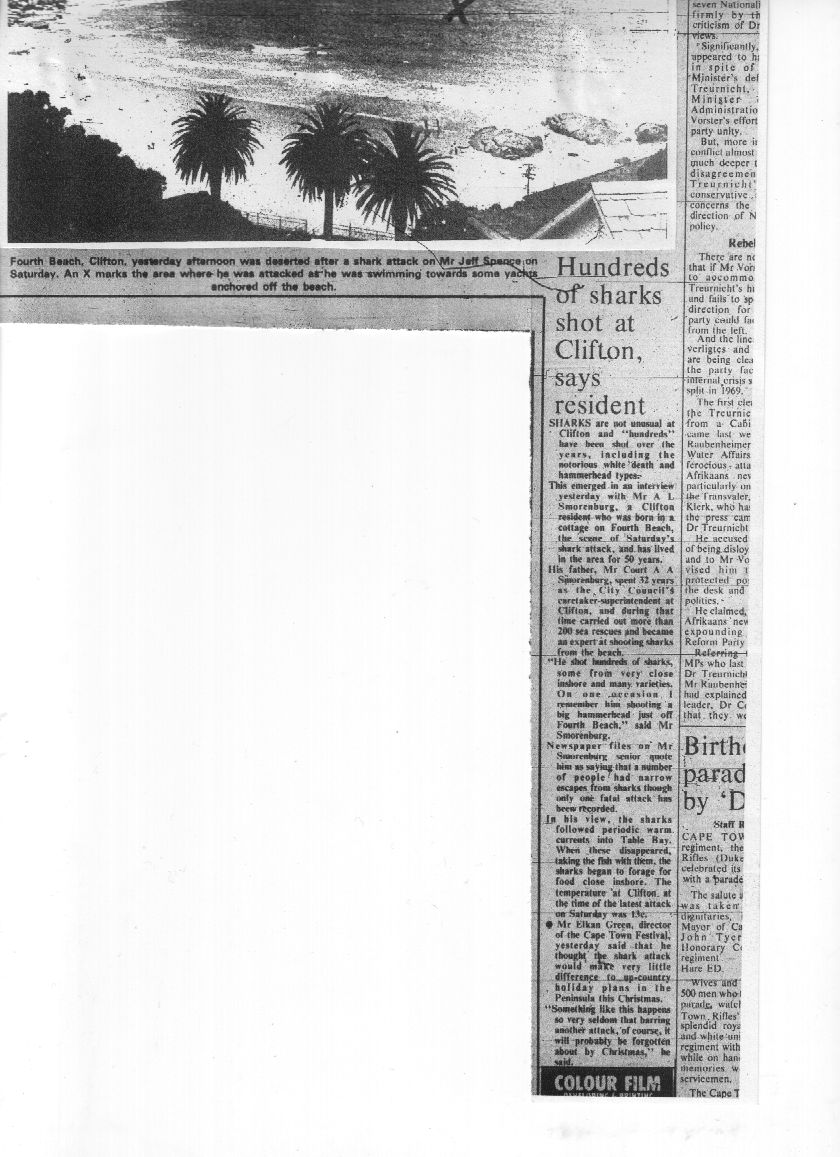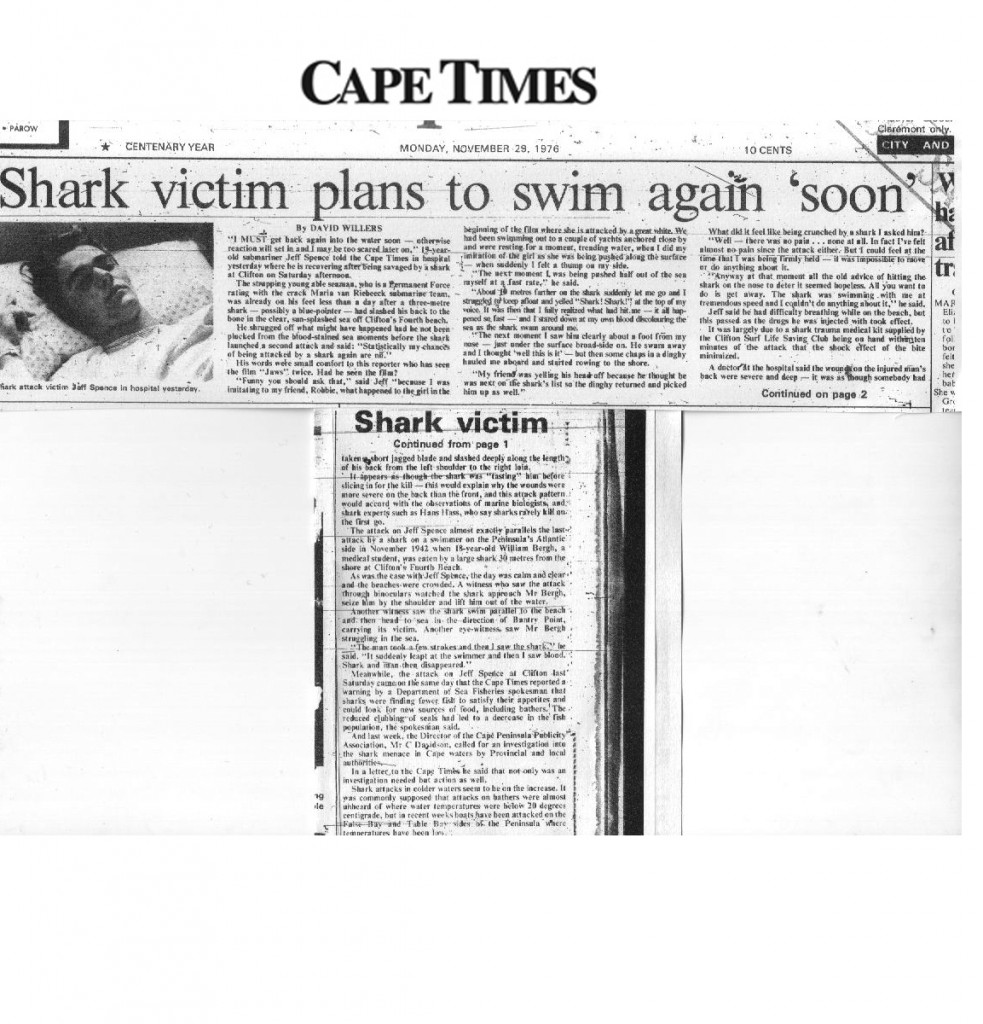Archive for Media
Sharks may be a bigger threat
Weekend Argus, Early November: GREAT WHITE sharks around the Cape coast could pose a far more dangerous threat to surfers and swimmers during the next few months than they have in the past.
According to spokesman for the Department of Sea Fisheries, the reduced clubbing of seals has meant there are more seals around the Cape Coast. They are eating 200,000 tones of fish each year and thus the shark is finding it increasingly difficult to find enough fish to satisfy its appetite.
As a result, sharks could be looking for new sources of food, including bathers.
Local shark hunter, Mr. Danie Schoeman, who caught a great white shark in False Bay a few weeks ago has been asked by the department to catch a shark for study purposes.
The contents of the shark’s stomach will be examined to discover whether the normal diet of local sharks is being supplemented by other food.
“We must have a great white as this is the one that has been threatening fishing boats and swimmers in the area recently. The one Schoeman caught last month was shipped to America whole so were unable to examine the stomach,” the spokesman said.
About 80,000 seals were clubbed to death off the South African coast last year, but following a pleas put forward by a team of conservationists, clubbing was thought to have decreased during the last season.
Weather permitting, Mr. Schoeman and local photographer, Mr. John Visser will search for great white sharks tomorrow.
“Three weeks of constantly bad weather has put us behind schedule. We hope to either get the “Submarine” or “Spotty” and Mr. Visser will film the catch for overseas television,” said Mr. Schoeman yesterday.
He added that he had also been approached by the South African Museum to catch a shark for them.
Afterward Mr. Schoeman and Mr. Visser intend traveling to Mauritius to catch hammerhead shark.
“We also hope to go to the Seychelles where we’ll search for the bronze whales which can be up to 18 metros long.”
Hundreds of sharks shot at Clifton, says resident
Cape Times, November 29, 1976: SHARKS are not unusual at Clifton and “hundreds” have been shot over the years, including the notorious white death and hammerhead types.
This emerged in an interview yesterday with Mr. A L Smorenburg, a Clifton resident who was born in a cottage on Fourth Beach, The scene of Saturday’s shark attack, and has lived in the area for 50 years.
His father, Mr. Court AA Smorenburg, was 32 years as the City Council’s caretaker-superintendent at Clifton, and during that time carried out more than 200 sea rescues and became an expert at shooting sharks from the beach.
“He shot hundreds of sharks, some from very close inshore and many varieties. On one occasion, I remember him shooting a big hammerhead just off Fourth Beach,” said Mr. Smorenburg.
Newspaper files on Mr. Smorenburg senior quote him as saying that a number of people had narrow escapes from sharks though only one fatal attack has been recorded.
In his view, the sharks followed periodic warm currents into Table Bay. When these disappeared, taking the fish with them, the sharks began to forage for food close inshore. The temperature at Clifton at the time of the latest attack was 18 C.
Mr. Elkan Green, director of the Cape Town Festival , yesterday said he thought the shark attack would make very little difference to up-country holiday plans in the Peninsula this Christmas.
“Something like this happens so seldom that barring another attack, of course, it will probably be forgotten about by Christmas,” he said
Photo Caption
Fourth Beach, Clifton, yesterday afternoon was deserted after a shark attack on Mr. Jeff Spence on Saturday. An X marks the area where he was attacked as he was swimming towards some yachts anchored off the beach.
Shark Victim Plans to Swim Again ‘Soon’
Cape Times, 29 November 1976: “I MUST get back into the water soon – otherwise reaction will set in and I may be too scared later on,” 19-year old submariner Jeff Spence told the Cape Times in hospital yesterday, where he is recovering after being savaged by a shark at Clifton on Saturday afternoon.
The strapping young able seaman, who is a Permanent Force rating with the crack Maria van Riebeeck submarine team, was already on his feet a day after a three-metre shark – possibly a blue-pointer – had slashed his back to the bone, in the clear, sun-splashed sea off Clifton’s Fourth beach.
He shrugged off what might have happened had he not been plucked from the blood-stained sea moments before the shark launched a second attack and said: “Statistically my chances at being attacked by a shark again are nil.”
His words were small comfort to this reporter who has seen the film “Jaws” twice. Had he seen the film?
“Funny you should ask that,” said Jeff “because I was imitating to my friend, Robbie, what happened to the girl in the beginning of the film where she is attacked by a great white. We had been swimming out to a couple of yachts anchored close by and were resting for a moment, treading water, when I did my imitation of the girl as she was being pushed along the surface – when suddenly I felt a thump on my side.
“The next moment I was being pushed half out of the sea myself at a fast rate,” he said.
“About 10 metres farther on the shark suddenly let me go and I struggled to keep afloat and yelled “Shark! Shark!” at the top of my voice. It was then that I fully realised what had hit me – it all happened so fast – and I stared down at my own blood discolouring the sea as the shark swam around me.
“The next moment I saw him clearly about a foot from my nose – just under the surface broad-side on. He swam away and I thought ‘well this is it’ – but then some chaps in a dinghy hauled me aboard and started rowing to the shore.
“My friend was yelling his head off because he thought he was next on the shark’s list so the dinghy returned and picked him up as well.”
What did it feel like being crunched by a shark I asked him.
“Well – there was no pain…none at all. In fact I’ve felt almost no pain since the attack either. But I could feel at the time that I was being firmly held – it was impossible to move or do anything about it.
“Anyway at that moment all the old advice of hitting the shark on the nose to deter it seemed hopeless. All you want to do is get away. The shark was swimming with me at tremendous speed and I couldn’t do anything about it,” he said.
Jeff said he had difficulty breathing while on the beach, but this passed as the drugs he was injected with took effect.
It was largely due to a shark trauma medical kit supplied by the Clifton Surf Life Saving Club being on hand within ten minutes of the attack that the shock effect of the bite minimized.
A doctor at the hospital said the wounds on the injured man’s back were severe and deep – it was as though somebody had taken a short jagged blade and slashed deeply along the length of his back from the left shoulder to the right loin.
‘It appears as though the shark was “tasting” him before slicing in for the kill – this would explain why the wounds were more severe on the back than the front, and this attack pattern would accord with the observation of marine biologists and shark experts such as Hans Hass, who say sharks rarely kill on the first go.’
The attack on Jeff Spence almost exactly parallels the last attack by a shark on a swimmer on the Peninsula’s Atlantic side in November 1942, when 18-year-old William Bergh, a medical student, was eaten by a large shark 30 metres from the shore at Clifton’s Fourth Beach.
As was the case with Jeff Spence, the day was calm and clear and the beaches were crowded. A witness who saw the attack through binoculars watched the shark approach Mr Bergh, seize him by the shoulder and lift him out of the water.
Another witness saw the shark swim parallel to the beach and then head to sea in the direction of Bantry Point, carrying its victim. Another eye-witness saw Mr Bergh struggling in the sea.
“The man took a few strokes and then I saw the shark,” he said. “It suddenly leapt at the swimmer and then I saw blood. Shark and man then disappeared.”
Meanwhile, the attack on Jeff Spence at Clifton last Saturday came on the same day that the Cape Times reported a warning by a Department of Sea Fisheries spokesman that sharks were finding fewer fish to satisfy their appetites and could look for new sources of food, including bathers! The reduced clubbing of seals had led to a decrease in the fish population, the spokesman said.
And last week, the Director of the Cape Peninsula Publicity Association, Mr C Davidson, called for an investigation into the shark menace in cape waters by Provincial and local authorities.
In a letter to the Cape Times he said that not only was an investigation needed but action as well.
Shark attacks in colder waters seem to be on the increase. It was commonly supposed that attacks on bathers were almost unheard of where water temperatures were below 20 degrees centigrade, but in recent weeks boats have been attacked on the False Bay and Table Bay sides of the Peninsula “where temperatures have been low.”
Published in Cape Times, 29 November 1976, “Shark victim plans to swim again ‘soon’” By David Willers
Shark Attack at Clifton Beach
Weekend Argus, 27 November 1976: A YOUTH aged about 17 was badly mauled in a shark attack at Fourth Beach, Clifton, this afternoon before the eyes of horrified onlookers.
The victim is a Mr Jeff Spence of Highlands, Johannesburg, who is doing his naval training at Simonstown in the submarine Maria van Riebeeck.
He was swimming with a friend and a fellow trainee, Mr R.M. Nell about 200-300 meters from the beach.
Two students of the South African Merchant Naval Academy at Granger By, Mr Peter van Gysen and Mr Peter Kitt, who pulled the youth from the water, described the incident to a Weekend Argus reporter.
They said their boat the Howard Davies, was moored at Fourth Beach and they were going ashore in a dinghy when they heard shouts of “Shark, Shark”.
STRUGGLING
They saw two young boys in the water, one of whom was swimming towards the beach while the other appeared to be struggling.
They went to him in the dinghy and pulled him aboard and took him straight to the beach.
The youth had been bitten on the back and on one arm. An ambulance was called and he was given treatment on the beach, including a saline drip by a doctor who lives in Clifton.
Three of the doctors who attended the victim before the ambulance arrived said the injuries appeared serious.
Lifesavers immediately ordered all bathers out of the water and within seconds the sea was cleared.
A National Sea Rescue Institute launch was called out to patrol the seafront and the Fourth Beach lifesavers radioed for reinforcements to help them control the crowd.
Soon after the attack three men took off in a armed with a gun to took off to hunt the shark.
One man dived into the water to put down bait while the other two kept watch.
Any eyewitness, Argus reporter Lynne van Sanfen who lives at Third Beach said screams were heard coming from a bather who was swimming far out at Fourth Beach near the yachts.
BLOOD IN THE SURF
The water around the youth was red with blood, she said.
A rowing boat hurried to the scene and occupants pulled the victim aboard.
By the stage hordes of bathers were lining up the water’s edge.
The victim was lifted out the rowing boat on to the sand and given first aid treatment.
When the small boat was overturned to be washed out the surf was stained with blood.
Another eye witness of the attack Mr Kenny Findberg of the Bidge Clifton, saw a similar account of the attack.
He said it was difficult to determine how badly the victim was injured, “but the sea around was a mess of blood”.
A spokesman for the Clifton Lifesaving Club said this was the first attack of its kind at Clifton since 1947.
Published in Weekend Argus, 27 November 1976, “Shark Attack At Clifton” By Weekend Argus Reporters
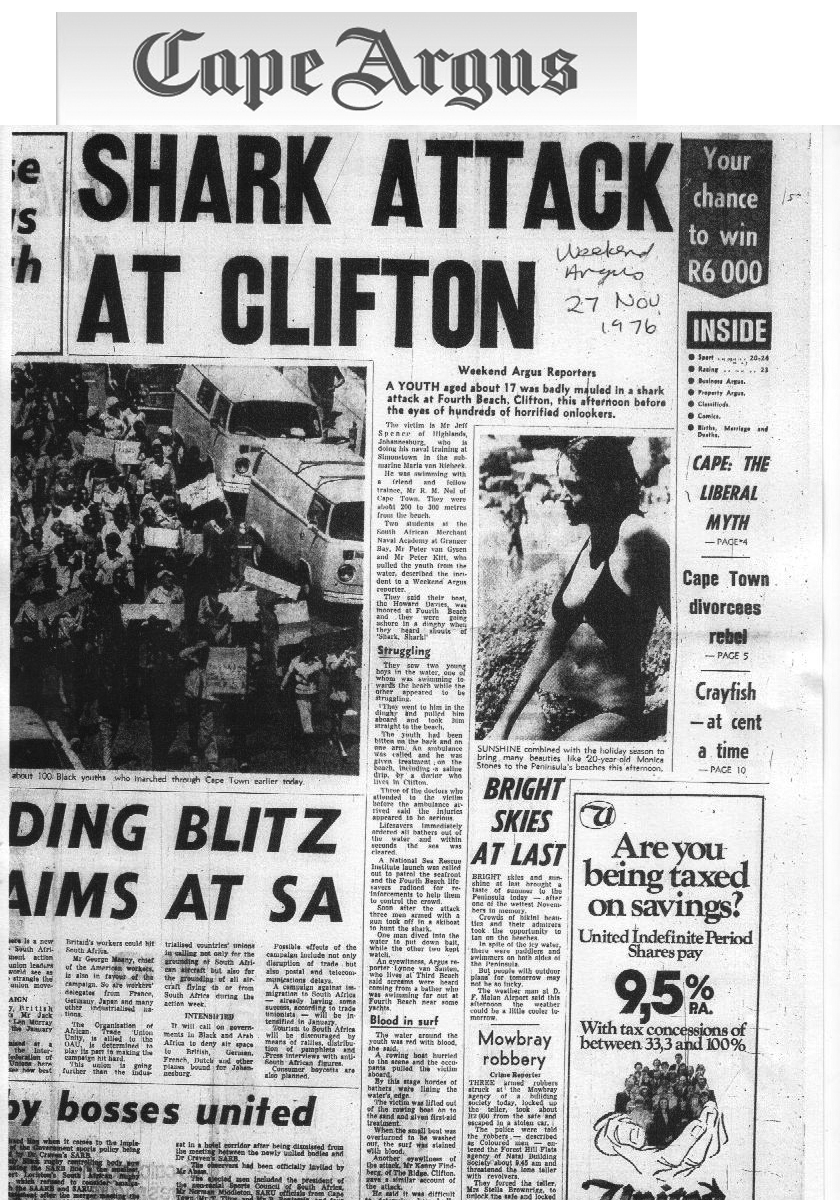
Davidson responds to “Sharks Should Thin The Mob”
Cape Times, 23 November 1976: THE last time I had reason I had reason to go into print over “PS”, by John Scott he been contemplating polluted waters off Mouille Point — on this occasion however (Cape Times, November 10, 1976) he has been down Muizenberg way.
Incidentally, John, did you travel to False bay by car — or do the noble thing and say “better far om petrol to bespaar to travel SAR”?
Your piece on nervousness (P.S., “Sharks Should Thin The Mob”) by your fictions Rhodesian relatives had us in fits of laughter — regrettably since my office is on the floor above the tourist information bureau I missed the hilarity.
However, Anita Ransmayr, who took your call, tells me she had the other two information assistants as well as two or three tourists who happened to be in the bureau at the same time straining to hear, for she realized it was a “put-pup job” and kept her cool as she went along with you.
When it was all over the suppressed laughter was allowed its full rein, one of the tourists thanked the staff for providing a floor show while they waited.
Seriously though – we are concerned and feel investigation and action, by provincial as well as local authorities is now required.
From Mr C Davidson, Director, Cape Peninsula Publicity Association, 23 November 1976.
Published Cape Times in response to the article “Sharks Should Thin The Mob” by John Scott in his column “P.S.” on 10 November 1976
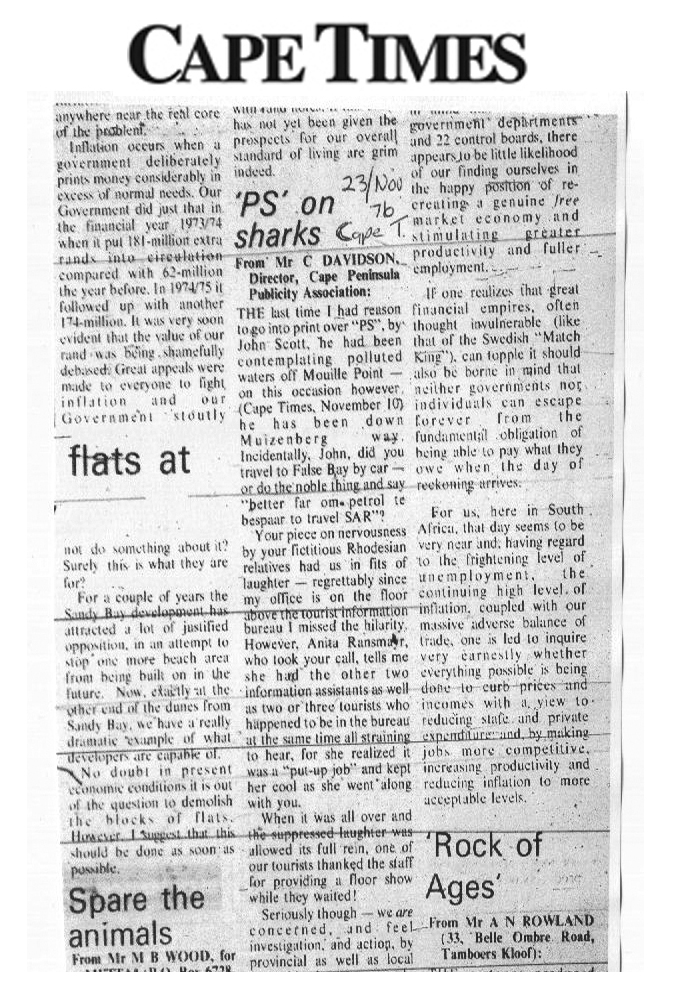
P.S. By John Scott: Sharks Should Thin The Mob
Cape Times, 10 November 1976: THE recent of shark sightings and catchings near the Macassar beach in False Bay has hardly put off a single visitor to the Cape. Don’t they read the newspapers?
I was hoping we might have a quiet summer for once. Let all the holidaymakers go to Durbs sun themselves this side of the shark nets.
Prospects of chasing away the madding crowd looked brighter with every report. Boatmen apparently seeing sharks in False Bay that reduce “Jaws” to an undersized upstart.
There is one they call the submarine. It is so big it sounds klaxon before it dives.
The fisherman offer their wooden boats as bait. Then, when a shark sinks his teeth into the hull they hit him over the head with the boathook.
The best known shark hunger, Mr Danie Schoeman of the Strand, started the season early by catching a four-metre monster over the weekend.
“Maybe there’ll be breathing space at Muizenburg beach for a change,” I thought.
To see how the water lay I telephoned the Muizenburg Publicity Association and I aid I had relatives in Rhodesia who are worried about coming to the Cape this summer because of the shark reports and pictures.
“What reports and pictures,” asked the lady.
“In the Burger this morning and in the Argus on Saturday,” I replied.
“Well there was certainly nothing about sharks in the Cape Times this morning,” said the lady with a finality that suggested all the other reports were suspect.
Unwilling to tamper with her total trust in the Cape Times and feeling a little guilty about my fictitious Rhodesian relatives I immediately phoned the Cape Peninsula Publicity Association with the same story.
“It is very seldom that sharks come close ashore in False Bay,” said their lady.
“There are only two or three floating around and they are trying to catch them”.
“What guarantee can I give my relatives if they won’t be bitten?”
“You can’ give them any guarantee. But I should imagine it’s more dangerous for them in Rhodesia a the moment that in False Bay.
“What should one do if one is attacked by a shark?”
“That is difficult to say. I have never been attacked by a shark. I might die of fright to star with. Why don’t you phone the department of fisheries? They will know exactly how many sharks there are in False Bay”
I didn’t because I knew they wouldn’t. But it was disheartening to discover that both publicity associations were so utterly sensible on the subject of shark.
And neither had received any shark enquiries, bar mine.
There is only one thing that stop the summer influx of upcountry hordes into their usual False Bay watering places. Mr Schoeman will have to bring the biggies ashore at Muizenburg, claim he found them knee-deep in surf and demand to have his picture taken exclusively by The Cape Times.
Cape Times, 10 November 1976, P.S By John Scott, “Sharks Should Thin The Mobs”
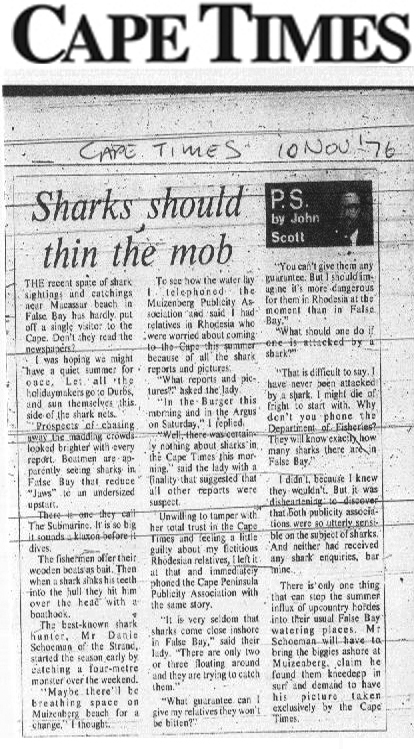
He Hopes to Spear ‘The Submarine’
Weekend Argus, 6 November 1976: SHARK hunter Danie Schoeman of The Strand is the this weekend mounting his first big foray of the season in a self-imposed mission to rid False Bay of two Great Whites which, he claims, are becoming an increasing threat to fisherman in small boats.
The two sharks are ‘The Submarine’ – an awesome creature estimated by those who claim to have seen it between four and seven metres – and ‘Spotty’ a smaller but reputedly more aggressive shark that owes its nickname to some distinct white spots on its back.
However, while few fisherman dispute the existence of the two sharks – there are numerous well documented sightings of ‘The Submarine’ in particular – they are sharply divided on the question of whether they should be hunted.
There are many who feel the sharks have not and will not deliberately attack fishermen’s boat, that they are not a threat to bathers and that they and other sharks actually aid fishermen by helping keep down the seal population.
NASTY
Danie Schoeman and those that support his views are convinced, however, that it is necessary to get rid of the sharks.
“Spotty in particular, is a nasty bit of work,” said Mr. Schoeman. “He charges anything in the water. There’s no question that the sharks have become more aggressive. Nowadays most of the people I know take a weapon with them when they go fishing off Macassar – anyone who does not is simply asking for trouble.”
“I take a homemade assegai but some of the chaps even take guns. I think we need to get rid of these sharks. The number of incidents involving them is increasing and I feel it is only a matter of time before something really dreadful happens.”
POWERFUL
The last time Mr. Schoeman saw ‘The Submarine’ was in January this year.
I actually had him on the line but he simply bent back my specially imported hook as if it were a piece of wire and he got away,” he said.
“He’s so powerful, that I don’t think we – even the tunny fishermen – have the equipment to catch him. However, we’ll see. This season for shark fishing, I’m using nylon rope, special hooks and buoy to keep the bait up.”
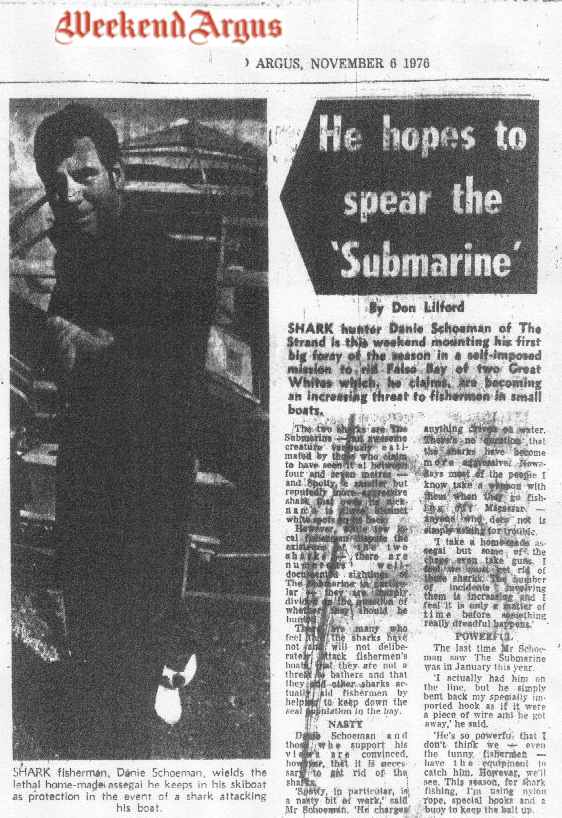
False Bay Sharks Turn Mean
Weekend Argus, 23 November 1976: FISHERMEN from Gordon’s Bay and The Strand are perturbed about the apparent increase in the audacity and aggressiveness of sharks in their region of False Bay as the summer season approaches. Continue Reading…


